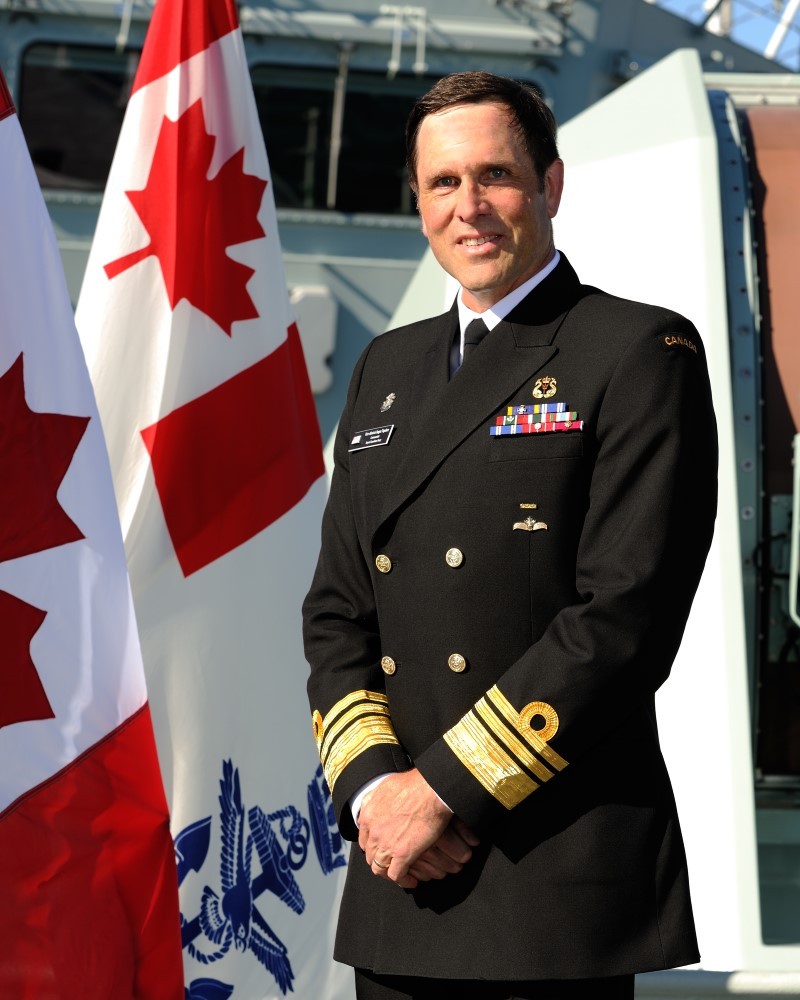“Canada’s commitment to the Indo-Pacific is year-round”
 Vice-Admiral Angus Topshee Foto: Royal Canadian Navy
Vice-Admiral Angus Topshee Foto: Royal Canadian Navy
Vice-Admiral Angus Topshee, Commander der Royal Canadian Navy, erläutert Kanadas Strategie im Indo-Pazifik. Im Gespräch hebt er die Bedeutung freier, offener und sicherer Seefahrtswege in dieser Region hervor und skizziert die weltweiten Operationen der kanadischen Flotte. Das Interview fand im Nachgang zur Deutsch-Kanadischen Konferenz in Ottawa statt.
Vice-Admiral Topshee, what role does the Indo-Pacific play in strategic planning?
The Indo-Pacific region will play a critical role in shaping Canada’s future over the next half-century. Encompassing 40 economies, over four billion people and $47.19 trillion in economic activity, it is the world’s fastest-growing region and home to six of Canada’s top 13 trading partners. The Indo-Pacific region represents significant opportunities for growing the Canadian economy and advancing the interests of Canadian workers and businesses for decades to come. In terms of strategic planning for the Royal Canadian Navy, the current deployment model ensures the RCN is meeting commitments to both NATO and the Indo-Pacific region.
In accordance with the Indo-Pacific Strategy, the RCN will be sending three frigates dedicated to upholding the international law of the sea, including the UN convention through forward naval presence operations, in the waters of the Indo-Pacific to demonstrate that Canada’s commitment to that region of the world is year-round.
What are the biggest challenges the RCN faces in maintaining a free and open Indo-Pacific?
One of the Royal Canadian Navy’s most critical roles in the Indo-Pacific region is to contribute to overall security and support the international rules-based order at sea. Stability in the Indo-Pacific is essential to global stability. The region is home to numerous security hotspots with potential global repercussions, and Canada must engage as a regional security partner to protect our national interests and security. The RCN as per the Indo-Pacific Strategy will additionally seek to address the climate change portion of the security spectrum in this region; and will collaborate with regional fisheries, the Canadian Coast Guard and allied coast guards to deter illegal, underreported, or unregulated fishing occurring within economic zones.
What is the status of the Royal Canadian Navy? Tell us more about Ship maintenance and availability.
The Royal Canadian Navy is currently conducting operations across the globe, with Maritime Coastal Defense Vessels HMCS Summerside and Shawinigan having just departed in early July to join Standing NATO Mine Countermeasures Group 1 (SNMCMG1) in European waters, frigates HMCS Ottawa and Vancouver deploying in August on Operation HORIZON in the Indo-Pacific region, and the first in class Arctic and Offshore Patrol Vessel HMCS Harry DeWolf departing for Operation NANOOK throughout the Canadian Arctic this fall.
Security at home starts on the high seas. As the RCN works together with like-minded nations, we underpin stability for all. To ensure our fleet can fulfil our Navy’s commitments, strategic choices are made to match appropriate platforms to specific responsibilities, and scheduling of deployments aids to avoid lengthy transit and allow for force generation time, accommodates force generation training, and builds crucial experiences and skills for our professional sailors. Overall, in terms of ship maintenance, the RCN is examining the level of investment needed for the length of time required for ship service life and is planning accordingly for maintenance periods to allow for preventative maintenance and the upgrading of new systems and/or equipment.
The RCN is also undergoing the most comprehensive fleet modernization in its peacetime history. Three new platforms are at various stages of entering the RCN fleet. The Arctic and Offshore Patrol Ship (AOPS) class are entering operational status in the fleet, with HMC Ships Harry DeWolf and Margaret Brooke already having deployed, and HMCS Max Bernays soon to be turned over to the RCN for sea trials. The remaining three AOPS are under construction.
As indicated in Canada’s defense policy, Strong, Secure, Engaged, the Government is acquiring 15 surface combatants. The Canadian Surface Combatant (CSC) is the largest, most complex procurement undertaken by the Government of Canada. Secondly, Joint Support Ships will form the core of the future fleet of the RCN. As auxiliary oiler replenishment vessels, they will surpass the operational capabilities of their predecessors. Together with the Joint Support Ships, the CSCs will form the core of the RCN’s future fleet.
The work our ships and sailors undertake overseas reinforces Canadian diplomatic efforts, promotes Canadian values, and reinforces our national credibility on the world stage, a challenge which we are proud to tackle.
What are some of the challenges with maritime security situation and the like?
Canada, at its heart, is a maritime trading and seafaring nation. In 2019, roughly $336 billion (28%) of Canada’s approximate $1.2 trillion in total goods trade was transported by sea. By working to ensure free and open trade on the world’s oceans, the RCN has a direct impact on our economy. Stability at sea helps Canada thrive, economically, socially and politically. One of the Navy’s critical roles is to make sure that peaceful exchange of goods occurs and follows the fundamental structure under the United Nations Convention on the Law of the Sea. Because of this, the RCN is called to serve and patrol across the globe.
The work our ships and sailors undertake overseas reinforces Canadian diplomatic efforts, promotes Canadian values, and reinforces our national credibility on the world stage, a challenge which we are proud to tackle.
What is the RCN doing about personnel issues and retention with regard to the Naval Experience Program?
The Navy — like the rest of the Canadian Armed Forces — has encountered challenges with recruiting, training, and retaining diverse Canadian talent. Therefore, the Navy is rethinking the way we attract, recruit, and train sailors. The Naval Experience Program (NEP) is the newest tool in the Royal Canadian Navy’s toolbox to help accomplish this. The overall concept is to reduce the amount of time it takes to train civilians into sailors while allowing them to experience life in the Navy before choosing a trade. The Naval Experience Program’s aim is simple: to foster the development of sailors who love their work and who enjoy the unique lifestyle that the Navy offers. After a one-year Term of Service, participants can either choose to continue to serve with the Navy, either full or part-time. The program also allows the Navy to assess the suitability of new recruits with the Canadian Armed Forces ethos and Code of Conduct. As of July 5, 2023, 326 applicants have begun their recruiting journey through the NEP.
Vice-Admiral Angus Topshee ist der 38. Commander der Royal Canadian Navy. Hier erfahren Sie mehr über ihn.
